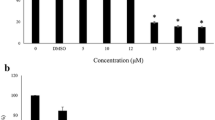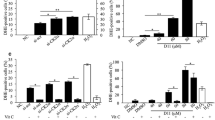Abstract
Serum deprivation-triggered increases in reactive oxygen species (ROS) are known to induce apoptotic cell death. However, the mechanism by which serum deprivation causes ROS production is not known. Since mitochondria are the main source of ROS and since mitochondrial ROS modulator 1 (Romo1) is involved in ROS production, we sought to determine if serum deprivation triggered ROS production through Romo1. To examine the relationship between Romo1 and the serum deprivation-triggered increase in ROS, we transfected Romo1 siRNA into various cell lines and looked for inhibition of mitochondrial ROS generation. Romo1 knockdown by Romo1 siRNA blocked the mitochondrial ROS production caused by serum deprivation, which originates in the mitochondrial electron transport chain. We also found that Romo1 knockdown inhibited serum deprivation-induced apoptosis. These findings suggest that Romo1-derived ROS play an important role in apoptotic cell death triggered by withdrawal of cell survival factors.












Similar content being viewed by others
Abbreviations
- ROS:
-
Reactive oxygen species
- Romo1:
-
Reactive oxygen species modulator 1
- siRNA:
-
Small interfering RNA
- DCF-DA:
-
2′,7′- Dichlorofluorescein diacetate
- H2O2:
-
Hydrogen peroxide
- PBS:
-
Phosphate-buffered saline
- Trolox:
-
6-Hydroxy-2,5,7,8-tetramethylchroman-2-carboxylic acid
- VDAC:
-
Voltage-dependent anion channel
- FBS:
-
Fetal bovine serum
References
van der Valk J, Mellor D, Brands R et al (2004) The humane collection of fetal bovine serum and possibilities for serum-free cell and tissue culture. Toxicol In Vitro 18:1–12. doi:10.1016/j.tiv.2003.08.009
King AR, Francis SE, Bridgeman CJ, Bird H, Whyte MK, Crossman DC (2003) A role for caspase-1 in serum withdrawal-induced apoptosis of endothelial cells. Lab Invest 83:1497–1508
Pandey S, Lopez C, Jammu A (2003) Oxidative stress and activation of proteasome protease during serum deprivation-induced apoptosis in rat hepatoma cells; inhibition of cell death by melatonin. Apoptosis 8:497–508. doi:10.1023/A:1025542424986
Satoh T, Sakai N, Enokido Y, Uchiyama Y, Hatanaka H (1996) Survival factor-insensitive generation of reactive oxygen species induced by serum deprivation in neuronal cells. Brain Res 733:9–14. doi:10.1016/0006-8993(96)00527-6
Zhuge J, Cederbaum AI (2006) Serum deprivation-induced HepG2 cell death is potentiated by CYP2E1. Free Radic Biol Med 40:63–74. doi:10.1016/j.freeradbiomed.2005.08.012
Bialik S, Cryns VL, Drincic A et al (1999) The mitochondrial apoptotic pathway is activated by serum and glucose deprivation in cardiac myocytes. Circ Res 85:403–414
Greene LA (1978) Nerve growth factor prevents the death and stimulates the neuronal differentiation of clonal PC12 pheochromocytoma cells in serum-free medium. J Cell Biol 78:747–755
Ferrari G, Yan CY, Greene LA (1995) N-acetylcysteine (D- and L-stereoisomers) prevents apoptotic death of neuronal cells. J Neurosci 15:2857–2866
Droge W (2002) Free radicals in the physiological control of cell function. Physiol Rev 82:47–95. doi:10.1152/physrev.00018.2001
Martindale JL, Holbrook NJ (2002) Cellular response to oxidative stress: signaling for suicide and survival. J Cell Physiol 192:1–15. doi:10.1002/jcp.10119
Finkel T (2003) Oxidant signals and oxidative stress. Curr Opin Cell Biol 15:247–254. doi:10.1016/S0955-0674(03)00002-4
Turrens JF (2003) Mitochondrial formation of reactive oxygen species. J Physiol 552:335–344. doi:10.1113/jphysiol.2003.049478
Burdon RH, Rice-Evans C (1989) Free radicals and the regulation of mammalian cell proliferation. Free Radic Res Commun 6:345–358. doi:10.3109/10715768909087918
Stone JR, Yang S (2006) Hydrogen peroxide: a signaling messenger. Antioxid Redox Signal 8:243–270. doi:10.1089/ars.2006.8.243
Green DR, Reed JC (1998) Mitochondria and apoptosis. Science 281:1309–1312. doi:10.1126/science.281.5381.1309
Li P, Nijhawan D, Budihardjo I et al (1997) Cytochrome c and dATP-dependent formation of Apaf-1/caspase-9 complex initiates an apoptotic protease cascade. Cell 91:479–489
Finucane DM, Bossy-Wetzel E, Waterhouse NJ, Cotter TG, Green DR (1999) Bax-induced caspase activation and apoptosis via cytochrome c release from mitochondria is inhibitable by Bcl-xL. J Biol Chem 274:2225–2233
Charles I, Khalyfa A, Kumar DM et al (2005) Serum deprivation induces apoptotic cell death of transformed rat retinal ganglion cells via mitochondrial signaling pathways. Invest Ophthalmol Vis Sci 46:1330–1338. doi:10.1167/iovs.04-0363
Chung YM, Kim JS, Yoo YD (2006) A novel protein, Romo1, induces ROS production in the mitochondria. Biochem Biophys Res Commun 347:649–655. doi:10.1016/j.bbrc.2006.06.140
Chung YM, Lee SB, Kim HJ et al (2008) Replicative senescence induced by romo1-derived reactive oxygen species. J Biol Chem 283:33763–33771. doi:10.1074/jbc.M805334200
Na AR, Chung YM, Lee SB, Park SH, Lee MS, Yoo YD (2008) A critical role for Romo1-derived ROS in cell proliferation. Biochem Biophys Res Commun 369:672–678. doi:10.1016/j.bbrc.2008.02.098
Chung JS, Lee SB, Park SH, et al. (2009) Mitochondrial reactive oxygen species originating from Romo1 exert an important role in normal cell cycle progression by regulating p27(Kip1) expression. Free Radic Res (in press)
Hwang IT, Chung YM, Kim JJ et al (2007) Drug resistance to 5-FU linked to reactive oxygen species modulator 1. Biochem Biophys Res Commun 359:304–310. doi:10.1016/j.bbrc.2007.05.088
Gozuacik D, Kimchi A (2004) Autophagy as a cell death and tumor suppressor mechanism. Oncogene 23:2891–2906. doi:10.1038/sj.onc.1207521
Kerr JF, Wyllie AH, Currie AR (1972) Apoptosis: a basic biological phenomenon with wide-ranging implications in tissue kinetics. Br J Cancer 26:239–257
Simon HU, Haj-Yehia A, Levi-Schaffer F (2000) Role of reactive oxygen species (ROS) in apoptosis induction. Apoptosis 5:415–418. doi:10.1023/A:1009616228304
Kang S, Song J, Kang H, Kim S, Lee Y, Park D (2003) Insulin can block apoptosis by decreasing oxidative stress via phosphatidylinositol 3-kinase- and extracellular signal-regulated protein kinase-dependent signaling pathways in HepG2 cells. Eur J Endocrinol 148:147–155. doi:10.1530/eje.0.1480147
Muller FL, Liu Y, Van Remmen H (2004) Complex III releases superoxide to both sides of the inner mitochondrial membrane. J Biol Chem 279:49064–49073. doi:10.1074/jbc.M407715200
Acknowledgments
This work was supported by Grant FG06-2-20 from the twentieth Century Frontier Functional Human Genome Project funded by the Korea Government (MEST), by a grant of the Korea Healthcare technology R and D Project, Ministry for Health, Welfare and Family Affairs, Republic of Korea (A084537), by Basic Science Research Program through the National Research Foundation (NRF) funded by the Ministry of Education, Science and Technology (R01-2006-000-10113-0), and by Grant R11-2005-017-01001-0 from the Research Center for Woman’s Diseases of the NRF.
Author information
Authors and Affiliations
Corresponding author
Rights and permissions
About this article
Cite this article
Lee, S.B., Kim, J.J., Kim, T.W. et al. Serum deprivation-induced reactive oxygen species production is mediated by Romo1. Apoptosis 15, 204–218 (2010). https://doi.org/10.1007/s10495-009-0411-1
Published:
Issue Date:
DOI: https://doi.org/10.1007/s10495-009-0411-1




